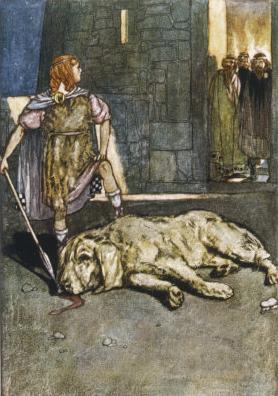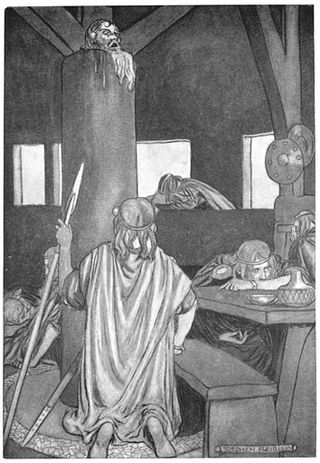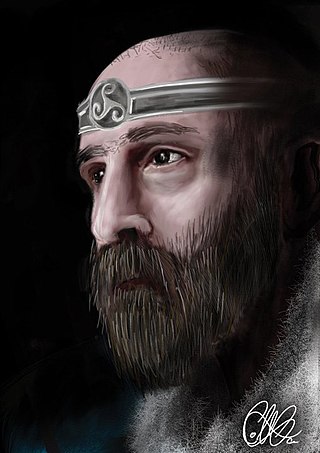Related Research Articles

Conchobarmac Nessa is the king of Ulster in the Ulster Cycle of Irish mythology. He rules from Emain Macha. He is usually said to be the son of the High King Fachtna Fáthach, although in some stories his father is the druid Cathbad, and he is usually known by his matronymic, mac Nessa: his mother is Ness, daughter of Eochaid Sálbuide, King of Ulster.

Cú Chulainn, is an Irish warrior hero and demigod in the Ulster Cycle of Irish mythology, as well as in Scottish and Manx folklore. He is believed to be an incarnation of the Irish god Lugh, who is also his father. His mother is the mortal Deichtine, sister of king Conchobar mac Nessa.

Súaltammac Róich is the mortal father of the hero Cúchulainn in the Ulster Cycle of Irish mythology. His wife is Deichtine, sister of Conchobar mac Nessa, king of Ulster. His brother is Fergus mac Róich.

Emer, in modern Irish Eimhear or Éimhear and in Scottish Gaelic Eimhir, is the name of the daughter of Forgall Monach and the wife of the hero Cú Chulainn in the Ulster Cycle of Irish mythology.

Fergus mac Róich/Róigh is an Irish hero and a character in the Ulster Cycle of Irish mythology. Formerly the king of Ulster, he is tricked out of the kingship and betrayed by Conchobar mac Nessa, becomes the ally and lover of Conchobar's enemy, queen Medb of Connacht, and joins her expedition against Ulster in the Táin Bó Cúailnge. Fergus is described as being of huge size and sexual potency. This leads him into many a precarious situation as in the story of the Táin Bó Flidhais.

Ailill mac Máta is the king of the Connachta and the husband of queen Medb in the Ulster Cycle of Irish mythology. He rules from Cruachan.

Táin Bó Cúailnge, commonly known as The Táin or less commonly as The Cattle Raid of Cooley, is an epic from Irish mythology. It is often called "the Irish Iliad", although like most other early Irish literature, the Táin is written in prosimetrum, i.e. prose with periodic additions of verse composed by the characters. The Táin tells of a war against Ulster by Queen Medb of Connacht and her husband King Ailill, who intend to steal the stud bull Donn Cuailnge. Due to a curse upon the king and warriors of Ulster, the invaders are opposed only by the young demigod, Cú Chulainn.

The Ulster Cycle, formerly known as the Red Branch Cycle, is a body of medieval Irish heroic legends and sagas of the Ulaid. It is set far in the past, in what is now eastern Ulster and northern Leinster, particularly counties Armagh, Down and Louth. It focuses on the mythical Ulster king Conchobar mac Nessa and his court at Emain Macha, the hero Cú Chulainn, and their conflict with the Connachta and queen Medb. The longest and most important tale is the epic Táin Bó Cúailnge. The Ulster Cycle is one of the four 'cycles' of Irish mythology and legend, along with the Mythological Cycle, the Fianna Cycle and the Kings' Cycle.
Cathbad or Cathbhadh is the chief druid in the court of King Conchobar mac Nessa in the Ulster Cycle of Irish Mythology.
Celtchar, son of Uthechar or Uthidir, is a character from the Ulster Cycle of Irish Mythology. In Scéla Mucce Maic Dathó he is described as "a grey, tall, very terrible hero of Ulster". When he challenges Cet mac Mágach for the champion's portion, Cet counters that he once emasculated Celtchar with a spear at Celtchar's own house. He lives in Dún Lethglaise, also known as the Mound of Down, or Rathkeltair in Downpatrick, County Down. His wife is Findmór of Dún Sobairche. He wields a spear or lance, the Lúin Cheltchair, whose lust for blood is so great it has to be dipped in a cauldron of poison to control it.
Lebor na hUidre or the Book of the Dun Cow is an Irish vellum manuscript dating to the 12th century. It is the oldest extant manuscript in Irish. It is held in the Royal Irish Academy and is badly damaged: only 67 leaves remain and many of the texts are incomplete. It is named after an anachronistic legend that it was made from the hide of a dun cow by Saint Ciarán of Clonmacnoise.
Athirne Ailgheasach, son of Ferchertne, is a poet and satirist of the court of Conchobar mac Nessa in the Ulster Cycle of Irish mythology, who abuses the privileges of poets.
Ness, also called Nessa, is a princess of the Ulaid and the mother of Conchobar mac Nessa in the Ulster Cycle of Irish mythology. Her father is Eochaid Sálbuide, king of the Ulaid.
Cormac Cond Longas was the eldest son of Conchobar mac Nessa by his own mother, Ness, in the Ulster Cycle of Irish mythology. His foster father was Fergus mac Róich.
Mugain, daughter of Eochaid Feidlech,, is a legendary queen in the Ulster Cycle of Irish mythology; characterized as the "Strumpet wife of Conchobar mac Nessa", the king of Ulster. Also styled Mumain, she had a son with him named Glaisne. She was also a sister of Medb by paternity.
In Irish mythology, Mesgegra was king of Leinster during the events of the Ulster Cycle, and was also the brother of Mac Da Thó aka Mes Róidia in The Tale of Mac Da Thó's Pig.
Flidas or Flidais is a female figure in Irish Mythology, known by the epithet Foltchaín. She is believed to have been a goddess of cattle and fertility.
The Yellow Book of Lecan, or TCD MS 1318, is a late medieval Irish manuscript. It contains much of the Ulster Cycle of Irish mythology, besides other material. It is held in the Library of Trinity College Dublin.
Compert Con Culainn is an early medieval Irish narrative about the conception and birth of the hero Cú Chulainn. Part of the Ulster Cycle of Irish mythology, it survives in two major versions.
The Tale of Mac Da Thó's Pig is a legendary tale in the Ulster Cycle.
References
- ↑ Stokes 1910b , p. 18, "The tractate which I have entitled 'Scéla Conchobair maic Nessa is found in the Book of Leinster (p.106a of the facsimile)"
- ↑ Abbott 1900 , p. 361, Abbott & Gwynn 1921 , p. 159
- ↑ e.g., Kuno Meyer 1884, RC 6, 173. "the LL Copy.."
- ↑ "MS-OMIT" . Retrieved 11 February 2012.
- ↑ O'Curry 1873 , pp. 332–333
- ↑ Kinsella 1969 tr., pp.3–8; Harry Mountain's Celtic Encyclopedia
- ↑ A Ol Guala is also mentioned in the Tochmarc Ferbe as a caldron full of wine in the house of Conchobar.
- ↑ Kinsella 1969 , pp. 3–8, also endnotes.
- ↑ Stokes 1910b , ¶13, p.26/27
- ↑ Petrie 1839 , PRIA 18, p.159